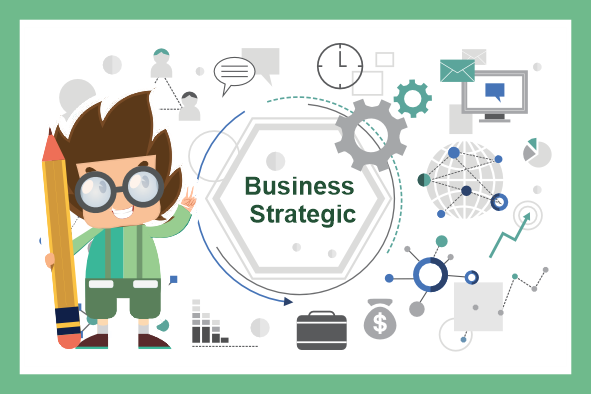Strategic Planning: Review This Before It’s That Time Again
Small Business
LAST UPDATE: Feb 25, 2023
6 minutes reading
Most larger firms periodically strategic plan for the future every three to five years. Documents related to strategic planning are frequently put on hold until the start of the following cycle. On the other side, many smaller and newer firms do not invest the necessary time and effort in the strategic planning process because they are driven by urgency.
Only 63% of companies make longer-term plans. A more thorough annual strategic planning process is essential for all organizations to ensure future success, profitability, value, and impact.
What is Strategic Planning in business?
Strategic planning is the skill of developing detailed business plans, putting them into action, and assessing the outcomes in light of a company’s overarching long-term objectives or aspirations. It is a theory that concentrates on integrating different corporate divisions (such as accounting and finance, marketing, and human resources) to achieve a company’s strategic objectives. Strategic management and strategic planning are fundamentally the same things.
What is Business Strategic Plan Management?
The method by which a firm develops and maintains a successful road map that guides the business year after year in the direction it must travel for long-term success is known as strategic business management. It includes all phases, from conception and research to implementation, assessment, and adjustment. Strategic management is more relevant and crucial than ever for establishing measurable goals and taking appropriate action given the speed of change.
Because the strategic management team is not present at the planning table from the start, many firms fail. A strategic plan’s effectiveness depends on how well it can be carried out and maintained.
Read more About: 11 Steps to Write Effective Business Reports
What is a Strategy Map?
A strategy map is a straightforward diagram that depicts the relationship between strategic goals in a logical, cause-and-effect manner (shown as ovals on the map). As it is utilized to swiftly communicate how value is created by the organization, it is one of the most potent components of the balanced scorecard technique.
Any strategy communication endeavor can be greatly enhanced by strategy mapping. A graphic of your plan will be understood by many more employees than a written description will because most people learn best visually. Additionally, the act of creating a strategy map compels the team to reach a consensus on their goals in straightforward, understandable words. Every employee may see how they contribute to the accomplishment of the organization’s goals with a well-designed strategy map.
Also Read: Efficiently Annual Report for a company
Strategic Planning Benefits
Many businesses use reactive rather than proactive methods as a result of the unstable business climate. Reactive methods may necessitate a large investment of time and resources to execute, yet they are often only effective in the short term. Strategic planning enables businesses to take a more long-term approach to problem-solving and proactive planning. They allow a business to exert influence rather than just react to circumstances.
1- Helps Create Better Tactics by Employing a Methodical, Logical Approach.
This is frequently the most significant advantage. Regardless of the effectiveness of a particular strategy, some studies indicate that the strategic planning process itself significantly contributes to enhancing a company’s overall performance.
2- Improvements In Employer-Employee Communication
The success of the strategic planning process depends on communication. It is started via participation and communication between management and staff, demonstrating their dedication to accomplishing organizational goals.
Managers and staff can demonstrate their dedication to the organization’s aims with the help of strategic planning. This is so because they are aware of the business’s operations and motivations. When organizational goals and objectives are made concrete through strategic planning, employees are better able to appreciate the connection between their performance, the success of the business, and compensation. As a result, both staff members and management develop a greater capacity for innovation and creativity, which promotes the company’s continued expansion.
3- Empowers Those Who Are Employed by The Organization
Employees’ perceptions of their contribution to the success of the organization as a whole are strengthened by enhanced dialogue and communication throughout the entire process. Due to this, it is crucial for businesses to decentralize the strategic planning process by including employees and lower-level managers across the entire organization. An excellent example is the Walt Disney Company, which abolished its own strategic planning section in favor of distributing the planning responsibilities across the many Disney business divisions.
Also Read: What Is Business Financial Statements
What Are The 3 Steps in The Strategic Planning Process?
Upper-level management of a corporation must put a lot of thinking and planning into the strategic planning process. Executives may look at a wide range of choices before deciding on a course of action and then figuring out how to strategically implement it.
In the end, a company’s management will, hopefully, decide on a strategy that can be executed cost-effectively with a high possibility of success, while avoiding excessive financial risk, and that is most likely to deliver good results (often defined as enhancing the company’s bottom line).
Typically, strategic planning is developed and put into action through the following 3 crucial steps:
Strategy Formulation
A corporation will first conduct an internal and external audit to evaluate its current status before coming up with a strategy. Finding the organization’s strengths and weaknesses, as well as its possibilities and dangers, is the goal of this (SWOT Analysis). The study helps managers determine which strategies or markets to pursue or forgo, how to effectively use the company’s resources, and whether to take steps like expanding operations through a merger or joint venture.
Business strategies have a long-term impact on the success of organizations. The authority to allocate the resources required for its implementation typically only extends to high management leaders.
Strategy Implementation
The organization must commit resources for the strategy’s execution after formulating a plan of action and setting precise targets or goals for its implementation. How well upper management communicates the selected strategy across the organization and persuades everyone to “buy into” the desire to put the plan into action will frequently influence how well the implementation stage goes.
Creating a strong framework for the strategy’s execution, making the most of available resources, and refocusing marketing activities to align with the strategy’s goals and objectives are all necessary for effective strategy implementation.
Strategy Evaluation
Any astute businessman is aware that today’s success does not guarantee future success. As a result, it is critical for managers to assess the effectiveness of a chosen strategy following the implementation stage.
Reviewing the internal and external elements affecting the strategy’s execution, monitoring performance, and taking corrective action to improve the plan’s effectiveness are the three key components of strategy evaluation. For instance, a business might learn that, in order to achieve the required changes in customer relations, it needs to acquire a new Customer Relationship Management (CRM) software package after adopting a plan to improve customer service.
Conclusion
Strategic planning is being used by more and more businesses to create and carry out sound decisions. Even though it takes a lot of time, money, and effort to plan, a well-thought-out strategic plan effectively promotes business growth, goal achievement, and employee satisfaction.



Recent Comments